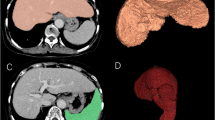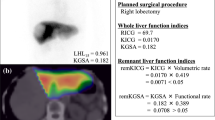Abstract.
It is extremely important to have a good grasp of the acceptable limit of hepatectomy before operation because postoperative liver failure can take a fatal course; however, baseline data on the limit of hepatectomy have not been clearly defined. We therefore evaluated and compared the predicted remnant liver function obtained by computed tomography(CT) and technetium-99m diethylenetriamine penta-acetic acid-galactosyl human serum albumin (99mTc-GSA) liver scintigraphy in order to obtain precise data regarding remnant liver function before hepatectomy. We investigated 20 patients undergoing hepatectomy using the clearance rate of indocyanine green (KICG) as a parameter, and compared the predicted postoperative KICG obtained by CT and by transaxial single-photon emission tomographic (SPET) images acquired by 99mTc GSA liver scintigraphy before hepatectomy. In GSA studies, based on time-activity curves for the heart and liver, we compared HH15 (heart activity at 15 min divided by heart activity at 3 min), LHL15 (liver activcity at 15 min divided by heart plus liver activity at 15 min) and KL (obtained from the time-activity curve for the liver) in 103 patients. In 58 patients without increased serum bilirubin, KL was compared with KICG. In four patients, occlusion of the right portal vein was performed with the aim of carrying out secondary hepatectomy, and changes in liver volume were compared between CT and 99mTc GSA liver scintigraphy. The correlation coefficient between the postoperative KICG predicted by CT and the actual postoperative KICG was rather poor, at r = 0.569 (P<0.05); that between the postoperative KICG predicted by 99mTc GSA liver scintigraphy and the actual postoperative KICG was good, at r = 0.788 (P<0.01); correlations between KL and HH15 and between KL and LHL15 in 103 patients were very good or good, at r = 0.906 (P<0.001) and r = 0.807 (P<0.001), respectively, and that between KL and KICG in 58 patients was very good, at r = 0.916 (P<0.001). In all four cases of right portal vein occlusion, the remnant liver volume ratio was markedly increased after occlusion in GSA compared with CT, and the postoperative KICG predicted by GSA after occlusion was closer to the actual postoperative KICG than that predicted by CT. It is concluded that 99mTc GSA liver scintigraphy is useful for predicting remnant liver function before hepatectomy and for evaluating changes in regional liver function after occlusion of the portal vein unilaterally.
Similar content being viewed by others
Author information
Authors and Affiliations
Additional information
Received 20 March and in revised form 24 June 1998
Rights and permissions
About this article
Cite this article
Mitsumori, A., Nagaya, I., Kimoto, S. et al. Preoperative evaluation of hepatic functional reserve following hepatectomy by technetium-99m galactosyl human serum albumin liver scintigraphy and computed tomography. Eur J Nucl Med 25, 1377–1382 (1998). https://doi.org/10.1007/s002590050311
Issue Date:
DOI: https://doi.org/10.1007/s002590050311




